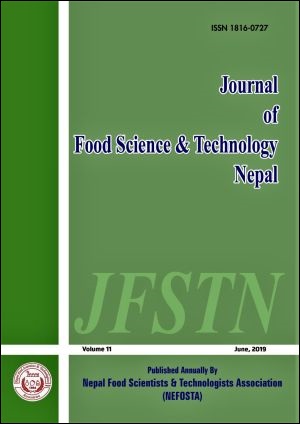Rheological and Sensory Attributes of Wheat, Quinoa and Buckwheat Composite Flour and their Use in Bakery Products
DOI:
https://doi.org/10.3126/jfstn.v11i0.29706Keywords:
Buckwheat, Cookies, Quinoa, Rheological properties, WheatAbstract
Pseudo cereals like Quinoa and Buckwheat are not true cereals because they have only structural and compositional resemblances with true cereals. These cereals are largely grown in all over the world. They are very important due to their excellent nutritional contents especially protein and bioactive components. Cookies were prepared by making composite flour of quinoa, buckwheat and wheat. Six treatments were prepared by adding 10%, 20% and 30% of quinoa flour with whole-wheat flour and buckwheat flour with whole-wheat flour along with controlled treatment To (100% wheat flour). Composite flours were analyzed for proximate, chemical and rheological properties. Cookies were subjected to sensory evaluation, chemical analysis, physical and textural analysis. Treatments such as 90% wheat flour + 10% buckwheat flour (T1 ), and 90% wheat flour + 10% quinoa flour (T4), showed best results in comparison with all other treatments. The cookies of treatment T1 and T4 for texture and color analysis showed best results as compared to other treatments. The proximate results of cookies showed that T1 and T4 contain 13.27%, 13.32% moisture content, 13.43%, 13.38% protein content, 22.12%, 30.08% fat content, 1.7%, 1.87% crude fiber and 1.01%, 1.19% ash content respectively. Sensory results of cookies evaluated that T1 of buckwheat and T4 of quinoa showed the best results. Furthermore, a bitter taste of cookies was developed in 80% wheat flour + 20% buckwheat flour (T2), 70% wheat flour + 30% buckwheat flour (T3) of buckwheat and 80% wheat flour + 20% quinoa flour (T5), 70% wheat flour + 30% quinoa flour (T6) of quinoa treatments. The collected data was subjected to statistical analysis to check the significance of the results in hot water extract.
Downloads
Downloads
Published
How to Cite
Issue
Section
License
The author will be the copyright holder of this open access journal - 'Journal of Food Science and Technology Nepal (JFSTN)'.




